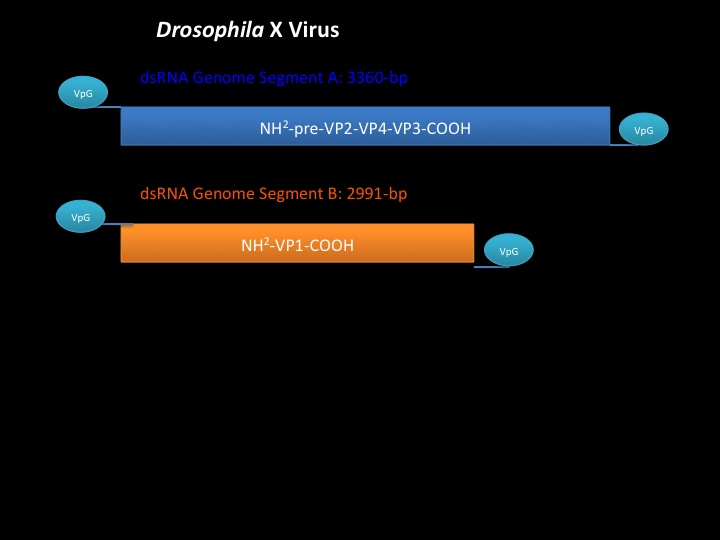|
Entomobirnavirus
''Entomobirnavirus'' is a genus of viruses in the family '' Birnaviridae''. Its natural host is the fly ''Drosophila melanogaster ''Drosophila melanogaster'' is a species of fly (the taxonomic order Diptera) in the family Drosophilidae. The species is often referred to as the fruit fly or lesser fruit fly, or less commonly the "vinegar fly" or "pomace fly". Starting with Ch ....'' There are two species in this genus. Taxonomy The genus contains the following species: * '' Drosophila X virus'' * '' Mosquito X virus'' Structure Viruses in the genus ''Entomobirnavirus'' are non-enveloped, with icosahedral and single-shelled geometries, and T=13 symmetry. The diameter is around 70 nm. Genomes are linear and segmented, around 15.3.2-3.5kb in length. The genome codes for 5 proteins. Life cycle Viral replication is cytoplasmic. Entry into the host cell is achieved by penetration into the host cell. Replication follows the double-stranded RNA virus replication model. Double-s ... [...More Info...] [...Related Items...] OR: [Wikipedia] [Google] [Baidu] |
Drosophila X Virus
Drosophila X virus (DXV) belongs to the ''Birnaviridae'' family of viruses. ''Birnaviridae'' currently consists of three genera. The first genus is ''Entomobirnavirus'', which contains DXV. The next genus is ''Aquabirnavirus'', containing infectious pancreatic necrosis virus (IPNV). The last genus is ''Avibirnavirus'', which contains infectious bursal disease virus (IBDV). All of these genera contain homology in three specific areas of their transcripts. The homology comes from the amino and carboxyl regions of preVP2, a small 21-residue-long domain near the carboxyl terminal of VP3, and similar small ORFs sequences. DXV was named after ''Drosophila melanogaster'', where it was first isolated. DXV was first isolated and named in 1978. DXV was discovered as a contaminant in adult ''D. melanogaster'' while studying rhabdoviruses. Assay results of DXV showed that DXV induces sensitivity to both carbon dioxide and NH2, which suggests general anoxia. Therefore, the pathogenic pathway f ... [...More Info...] [...Related Items...] OR: [Wikipedia] [Google] [Baidu] |
Birnaviridae
''Birnaviridae'' is a family of double-stranded RNA viruses. Salmonid fish, birds and insects serve as natural hosts. There are currently 11 species in this family, divided among seven genera. Diseases associated with this family include infectious pancreatic necrosis in salmonid fish, which causes significant losses to the aquaculture industry, with chronic infection in adult salmonid fish and acute viral disease in young salmonid fish. Structure Viruses in family ''Birnaviridae'' are non-enveloped, with icosahedral single-shelled geometries, and T=13 symmetry. The diameter is around 70 nm. Genome The genome is composed of linear, bi-segmented, double-stranded RNA. It is around 5.9–6.9 kbp in length and codes for five to six proteins. Birnaviruses encode the following proteins: RNA-directed RNA polymerase (VP1), which lacks the highly conserved Gly-Asp-Asp (GDD) sequence, a component of the proposed catalytic site of this enzyme family that exists in the conserve ... [...More Info...] [...Related Items...] OR: [Wikipedia] [Google] [Baidu] |
Viruses
A virus is a submicroscopic infectious agent that replicates only inside the living cells of an organism. Viruses infect all life forms, from animals and plants to microorganisms, including bacteria and archaea. Since Dmitri Ivanovsky's 1892 article describing a non-bacterial pathogen infecting tobacco plants and the discovery of the tobacco mosaic virus by Martinus Beijerinck in 1898,Dimmock p. 4 more than 9,000 virus species have been described in detail of the millions of types of viruses in the environment. Viruses are found in almost every ecosystem on Earth and are the most numerous type of biological entity. The study of viruses is known as virology, a subspeciality of microbiology. When infected, a host cell is often forced to rapidly produce thousands of copies of the original virus. When not inside an infected cell or in the process of infecting a cell, viruses exist in the form of independent particles, or ''virions'', consisting of (i) the genetic material, i.e ... [...More Info...] [...Related Items...] OR: [Wikipedia] [Google] [Baidu] |
Drosophila Melanogaster
''Drosophila melanogaster'' is a species of fly (the taxonomic order Diptera) in the family Drosophilidae. The species is often referred to as the fruit fly or lesser fruit fly, or less commonly the "vinegar fly" or "pomace fly". Starting with Charles W. Woodworth's 1901 proposal of the use of this species as a model organism, ''D. melanogaster'' continues to be widely used for biological research in genetics, physiology, microbial pathogenesis, and life history evolution. As of 2017, five Nobel Prizes have been awarded to drosophilists for their work using the insect. ''D. melanogaster'' is typically used in research owing to its rapid life cycle, relatively simple genetics with only four pairs of chromosomes, and large number of offspring per generation. It was originally an African species, with all non-African lineages having a common origin. Its geographic range includes all continents, including islands. ''D. melanogaster'' is a common pest in homes, restaurants, and othe ... [...More Info...] [...Related Items...] OR: [Wikipedia] [Google] [Baidu] |
Mosquito X Virus
Mosquitoes (or mosquitos) are members of a group of almost 3,600 species of small flies within the family Culicidae (from the Latin ''culex'' meaning " gnat"). The word "mosquito" (formed by ''mosca'' and diminutive ''-ito'') is Spanish for "little fly". Mosquitoes have a slender segmented body, one pair of wings, one pair of halteres, three pairs of long hair-like legs, and elongated mouthparts. The mosquito life cycle consists of egg, larva, pupa, and adult stages. Eggs are laid on the water surface; they hatch into motile larvae that feed on aquatic algae and organic material. These larvae are important food sources for many freshwater animals, such as dragonfly nymphs, many fish, and some birds such as ducks. The adult females of most species have tube-like mouthparts (called a proboscis) that can pierce the skin of a host and feed on blood, which contains protein and iron needed to produce eggs. Thousands of mosquito species feed on the blood of various hosts — ... [...More Info...] [...Related Items...] OR: [Wikipedia] [Google] [Baidu] |

.png)
